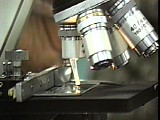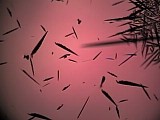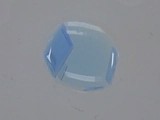A saturated solution is in equilibrium. The most general form of equation for a saturated solution can be represented as:
Solute + Solvent ![]() Solution
Solution
If we apply le Châtelier's principle, we can see that as the solvent evaporates, the reaction will try to shift to the left. In other words, as the solvent evaporates, more solute forms. If the solute is a solid (as it will be in most of the examples of solutions we study) then more solid will form as the solvent evaporates. Crystallization reactions which occur as the solvent evaporates are interesting reactions to observe.
Another kind of saturated solution involves precipitation reactions.

|
Paradichlorobenzene dissolves in acetone. A drop is placed on a microscope slide
and observed as the solvent evaporates. The reaction shifts left, producing
fascinating solid crystal patterns.

|
Iodine is dissolved in an organic solvent. The resulting solution is
purple. As the solvent evaporates, the equilibrium shifts to the left, producing
dark grey needlelike crystals of solid iodine. The purple color of the solution
dissapears.

|
Copper sulfate is dissolved in water. As the resulting blue solution evaporates, blue crystals form.